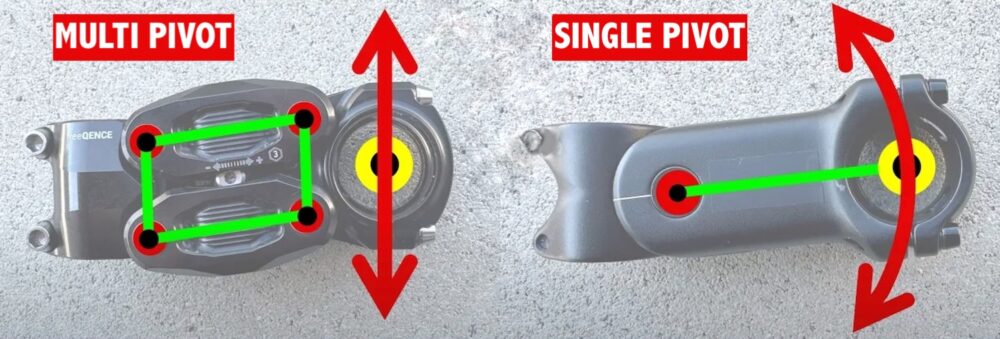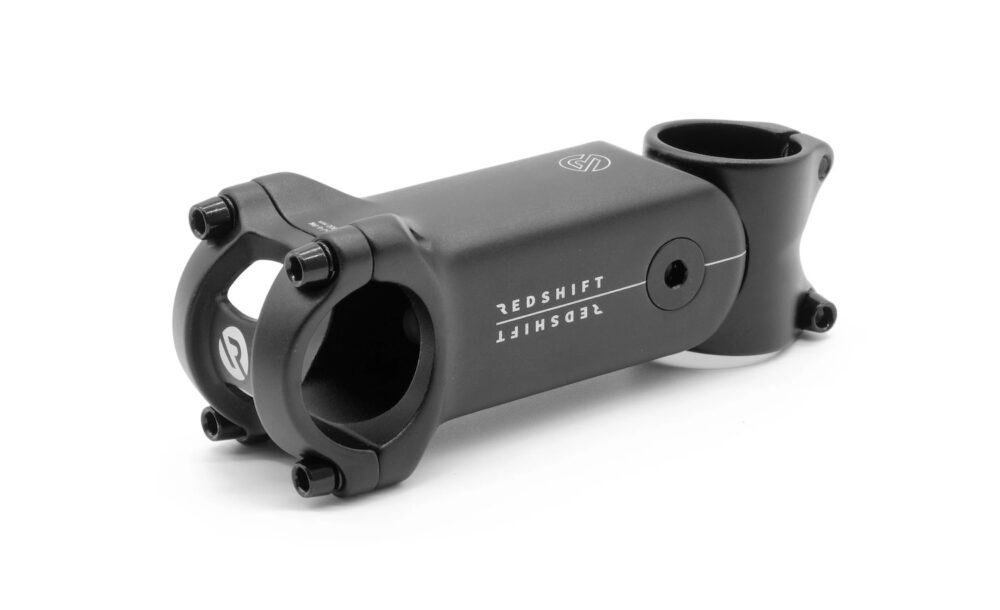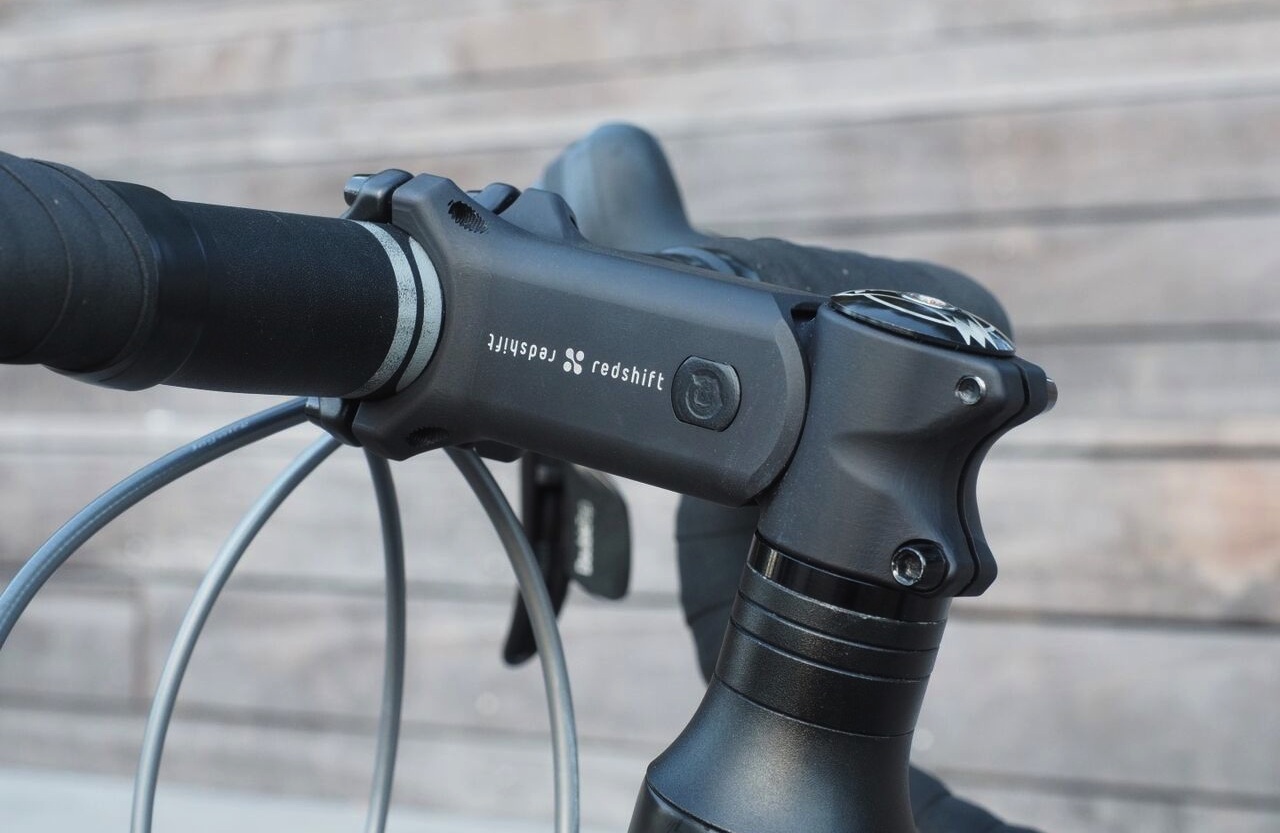The USE VYBE suspension stem has been designed to improve ride comfort while maintaining your bike’s aesthetics.
Thanks to 20mm of built-in suspension travel, this stem will reduce the jarring impact of bumps, potholes, and rough roads. This isolates your hands from road chatter, resulting in less fatigue and a more enjoyable time on the bike.
After testing many suspension stems over the years, the USE VYBE is one of the most effective and least intrusive products. Let’s take a closer look.
USE VYBE Suspension Stem
Linkage: Single Pivot
Spring Type: Elastomer
Length: 70 and 90 mm
Weight: 205 g / 7.2 oz
Travel: 20 mm / 0.8″
Bar Clamp: 31.8 mm
The USE VYBE suspension stem looks just like a regular stem, but hidden inside are some springs. An advantage to a design this simple is that you can maintain your bike’s aesthetic while minimising the added weight. The penalty is just 50 grams (1.8 oz) compared to a USE alloy rigid stem!
This suspension stem has a unique internal design with two elastomer springs. The bottom spring provides material damping when the stem compresses, and the top spring becomes active after the stem rebounds. This layout means it doesn’t experience ‘top out’ and it provides more damping than other stems over fast, repetitive bumps.
The USE VYBE suspension stem can be tailored to different rider weights and preferences by adjusting the spring rate. It comes with four elastomer springs (super soft, soft, medium and hard), which should suit riders from 50 kg (110 lb) right up to >100 kg (220 lb).

Once you’ve fitted the appropriate elastomers, you can now adjust the two independant pre-load screws – one for each elastomer spring. These are located on either side of the stem. Tightening these screws stiffens up the initial portion of the suspension travel, making it feel firmer, and taking away some of the ‘bounce’ or ‘springiness’ exhibited on other suspension stems.
It’s all sounding pretty good so far, but there are a few limitations to the USE VYBE stem.
USE VYBE Limitations
The VYBE stem only comes in two lengths (70 and 90 mm) and one steerer size (1 1/8″). This will suit some riders but will fall outside the appropriate length range for everyone else. The VYBE can only be installed at a positive angle, which will not work for all bike setups.
This stem is made in the UK, which makes the price high (£180). However, the advantage of local manufacturing is that USE can better control manufacturing tolerances and overall product quality. It is certainly made well.
Another minor thing is that it can’t fit integrated light or cycling computer stem mounts. As a result, your cockpit might not look as neat.
Pros and Cons: Single Pivot Design

The USE VYBE is a single pivot stem. It’s the lightest, simplest, and most ‘normal’ looking suspension stem design. But there are a few downsides.
Single pivot stems are highly effective in the brake hoods, less effective on the bar tops, and almost ineffective in the drops. This is because when your hands are in the drops, there is little leverage forward of the pivot point.
In addition, the suspension travel changes depending on where you place your hands. For example, if your hands are 50mm in front of the pivot point, rather than 100mm, you will only get half the suspension travel.
Single pivot stems also experience slight forward tilting of the handlebar when they compress, as it travels on an arc rather than a straight line. This is not too much of a hindrance, but it is noticeable.
Lastly, single pivot stems are less suitable with sweptback or flat bars. This is because your hands usually end up too close to the pivot point, reducing the available suspension travel.
In comparison, multi pivot stems like the Vecnum Freeqence keep your upper body suspended with the same spring rate, no matter where you place your hands on a drop bar. This ultimately means you will improve your comfort with your hands in the brake hoods, on the bar tops, or in the drops.
Multi pivot stems are highly compatible with sweptback and flat bars, as it doesn’t matter where your hands are relative to the pivot points.
The downsides are the increased complexity, weight, and change in aesthetics.
To see a video explanation of single pivot vs. multi pivot stems, watch Alee’s video HERE.
Changing The Elastomers

To swap elastomers, you need to unscrew the stem pivot bolt. My first attempt at changing the elastomers was with the handlebars on my bike, but this was a big mistake. As the elastomers weren’t held in place, everything fell apart after I had unscrewed the pivot bolt.
My second elastomer swap went much more smoothly as I decided to remove the stem from the bike. This helped not drop any stem components, but the elastomer changing process is undoubtedly more fiddly than a Redshift Shockstop stem.
A quick tip: The tuning bolts are attached to plastic plates, and if you’re not careful putting it all back together, it’s easy to misalign the components. Don’t fully unscrew these tuning bolts, or you’ll have problems!
You can see a video of USE Components making an elastomer swap HERE.
The Pivot Construction
Since the elastomers are only accessible after removing the pivot bolt, you need to make sure that the bolt is lined up and screwed tight (10Nm). I read a report of a journalist whose handlebars detached mid-ride. USE Components told me it was a pre-production stem, and the issue has since been resolved.
My production version has been solid. I’ve had no issues, though I did check the bolt every few rides to be sure. USE say the pivot bolt must be tightened to 10Nm. You can use a calibrated torque wrench to tighten the stem to the correct specification.
Let’s now get to what we’re all here for: the performance of the USE VYBE suspension stem!
Riding The USE Vybe Suspension Stem

I really like the USE VYBE stem. It’s firm without being harsh, doesn’t bottom out, and doesn’t exhibit strange noises. It’s a great balance of comfort and rigidity.
The suspension action is smooth and well-controlled. I never once felt the need for a lockout switch like on the Cane Creek eeSilk stem. Once the VYBE stem was fitted to my bike, I forgot it was there.
Surprisingly, the firm ride feel doesn’t come at the cost of vibration-damping ability. Once I dialled the stem settings in for my weight and preference, the USE VYBE delivered excellent overall comfort (see the results below).
The ability to mix elastomers and adjust the firmness makes the USE VYBE suspension stem perform so well that I questioned if I even need my HiRide suspension fork for most gravel terrain. After all, I could drop over 1 kg (2.2 lb) from my bike’s weight if I used this stem instead of a suspension fork.
That said, the USE VYBE cannot offer the same level of grip or overall bike stability over rough terrain as my suspension fork. This is because a suspension fork suspends not only your upper body but the entire front of your bike, allowing you to generate more front tire traction and achieve better braking.
In addition, my suspension fork uses a much more advanced hydraulic damper, so it can absorb more energy after bigger impacts.
The only downside of the USE VYBE suspension stem is that the handlebar tilts forward under compression. That feeling won’t be for everyone, but I believe this is a small price to pay for the significant comfort improvement.
My Test Bike and Vibration Measurement Procedure

I conducted this vibration test on my Mondraker Dusty gravel bike fitted with Teravail Rutland 700C x 42 mm tires at 40 PSI (2.8 bar). The bike was equipped with a carbon fork, Lauf Smoothie 44 cm wide handlebar and Spank Flare 24 Vibrocore wheels.
A direct comparison was made between a standard rigid stem, a USE VYBE suspension stem, and a Redshift ShockStop suspension stem. It was the same bike, same conditions, and all stems were 90 mm in length. The spring rate of the suspension stems was adjusted to my body weight and preferred riding style.
I have two test scenarios: a big hit test that simulates riding across a 30 mm tall obstacle like a tree root or edgy rock, and a high-frequency chatter test that simulates riding on a bumpy gravel road.
You can read more about my vibration measurement procedure HERE.
Vibration Test Results
Big Hit Test

| Average Acceleration (g) | Vibrations When Compared to the Rigid Stem | |
| Alloy Rigid Stem | 2.71 | – |
| USE VYBE Suspension Stem | 2.64 | 2.4% Fewer Vibrations |
| Redshift Suspension Stem | 2.60 | 4.1% Fewer Vibrations |
The USE VYBE and Redshift stems performed similarly in my big hit test, with the Redshift having a slight performance edge.
This test ultimately shows the limits of elastomer springs. To see a major improvement in this test, you ideally need a suspension fork with a hydraulic damper (eg. HiRide Sterra) to remove additional energy.
Alternatively, you can use the Vecnum Freeqence suspension stem, which has been the best-performing stem in this test. The secret is that the rebound speed is a touch slower, and it offers 10mm of upward suspension travel in addition to its 20mm of downward travel. This combination helps to mitigate oscillation.
High-Frequency Chatter Test

| Average Acceleration (g) | Vibrations When Compared to the Rigid Stem | |
| Alloy Rigid Stem | 2.44 | – |
| USE VYBE Suspension Stem | 2.02 | 17.1% Fewer Vibrations |
| Redshift Suspension Stem | 2.35 | 3.8% Fewer Vibrations |
In my lab test simulating fast, repetitive bumps, the USE VYBE outperforms other suspension stems by a significant margin.
It shows a 13.8% reduction in vibration compared to the Redshift Shockstop stem. This was such a big difference that I had to double-check my results to be sure. Yes, the same results again!
I suspect the top elastomer spring (that’s only present in the USE VYBE) is working overtime to damp high-frequency vibration. This is a finding I’m excited about!
USE VYBE vs Redshift Suspension Stem
When it comes to performance, the USE VYBE suspension stem has the upper hand. It’s not only lighter, but it damps more vibration over fast, repetitive bumps. You can also fine-tune the suspension movement using the preload adjustment, bringing an extra level of customisation.
Don’t write off the Redshift Suspension stem, though. You can buy it in more stem lengths (55 to 120mm) to dial in your bike fit. The Redshift ShockStop stem is a fair bit cheaper (>20%); it features a broader selection of elastomer spring rates, and swapping the elastomers is much easier.
It can also be run in a positive or negative orientation to put your handlebars at a height suitable for your needs. Lastly, stem accessory mounts are also available for your computer and/or light, saving handlebar real estate and neatening up the cockpit.
You can read my Redshift Shockstop suspension stem review HERE.
Summary
The USE VYBE performs exceptionally over fast, repetitive bumps. It’s easy to adjust and barely adds weight to your bike.
PROS
1. Impressive vibration damping on gravel
2. Excellent feel; never too bouncy
3. Aesthetics that match your bike
4. Very lightweight
CONS
1. Two stem lengths, positive rise only
2. Bars tilt forward under compression
3. Changing elastomers is finicky
4. Expensive
The USE VYBE suspension stem is one of the best-performing stems out there. It damps high-speed bumps incredibly well, and its adjustability is unmatched. The exceptionally low weight gives you one less excuse not to try it.
It’s one of many stem designs out there, each with pros and cons – you can learn more about the different stem designs in my Cycling Comfort Course (it’s 100% free).
Yes, it’s not cheap, but it’s still cheaper than a suspension fork. So, if you’re looking for extra comfort on a drop bar bike, I believe the USE VYBE is worth a shot.














